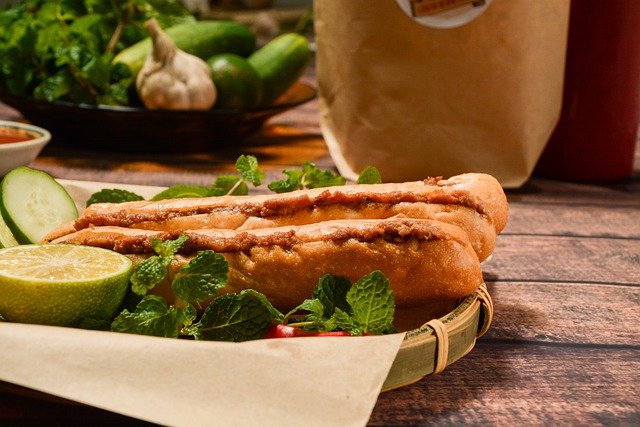If you are eager to start your own business this year and you want to combine your love of food with your entrepreneurial spirit, you might be considering a street food business. Street food is on-trend, with more people than ever eager for authentic food with a rustic edge. You need to understand recipes and be able to cook from your own heritage. If you have gastronomic flair and you want to feed the masses, think about purchasing a street food truck and attending some local events to show off your grub. Follow this guide and make your street food idea a profitable venture.
This is a contributed post. Please refer to my disclosure for more information.

The Plan
You need a plan before you can join the ranks of successful street food vendors. Here’s what to cover.
Strategic Planning and Funding
As with any business, you need to hone a plan. The better your business plan, the more profitable your venture will be. With a food business, you need to target the sorts of angel investors that have experience with restaurants and eateries.
Catering magnates are often eager to invest in up-and-coming food businesses that offer something different for hungry diners. Ensure that you do your market research and show off your ethos in your plan. Forget about printing off a generic template only to place it in a drawer, never to be seen again.
You need to crunch the numbers, know your gross from your net, and have some sound financial forecasting. When pitching for funding, be prepared for questioning. Get suited and booted, present your plan, and enthuse with your foodie ideas.
Market Analysis
Conducting a market analysis is pivotal before you start your own street food business. That process begins with identifying your target market. You must identify your potential customers. Know their age, income level, dining preferences, and eating habits.
Are they busy professionals looking for quick lunch options? Or are they food enthusiasts in search of unique culinary experiences? Perhaps you want to target a more youthful market and sell ice cream.
Once you’ve done that, analyze your competitors. You’ll want insights into their offerings, pricing, and customer engagement ideas. What sets them apart, and how can you make your business different?
Finally, delve into what customers want within the street food industry. This involves staying abreast of culinary trends. Check what’s popular with dietary requirements, too (such as vegan or gluten-free options). Don’t forget to research flavor profiles. Find the ones that resonate with the local marketing. By aligning your business model, you can tailor your offer accordingly.
Regulatory Requirements
Navigating the regulatory requirements is critical. Always do this before setting up street food businesses. You’ll need to secure the necessary permits and licenses. These vary by location, so check near where you live. You might also need food handler permits and street vending licenses.
Compliance with local health codes and food safety regulations is mandatory. It’s there to ensure the well-being of your customers. So, never ignore it.
It’s essential to research and understand these legal steps before you start. By doing so, you will avoid potential fines or disruptions.
Sustainability Practices
Incorporating sustainability practices into a street food business is not just a trend. It’s a commitment to the environment and community.
A focus on local produce is a great way to support regional farmers, reduce carbon footprints, and ensure the freshness of menu items. This approach aligns with the growing consumer demand for sustainable and ethical food choices. Plus, it enhances the brand identity of the business by associating it with quality and responsibility.
Additionally, adopting eco-friendly packaging solutions reflects a dedication to reducing waste and pollution. So it will resonate with environmentally conscious customers.
By integrating these practices, street food vendors can contribute to a more sustainable future. It also means they can cater to the eco-preferences of hungry customers looking for delicious food. Remember that many customers nowadays want street food options that align with their values.
The Food
Your long-term success rests on the quality of your food. Here’s how to get it right.
Decide On Your Cuisine
The most important part of any food venture is the cuisine you have on offer. Think about the sort of food that you love to eat and replicate this for the hungry public. If you adore vegan food, consider putting a plant-based twist onto your cuisine.
Ensure that your menu taps into the millennial psyche. Sustainable and ethical food is crucial in the twenty-first century. Focus on fusion cuisine. If you’ve never tried an Indian taco or some jerk jackfruit, rice, and peas, where have you been for the past eighteen months? You need to know what your diners want and pitch it at the right price point to be successful.
Menu Development
Developing a menu for your street food business requires a delicate balance. You need to offer high-quality food that appeals to a wide audience. But you also need to focus on an approach that allows for efficiency and consistency.
Begin with a core selection of dishes. Choose ones that best represent your brand’s identity and culinary strengths. You could incorporate new taste experiences by infusing traditional recipes with innovative twists. Catering to the adventurous palates of street food fans while retaining classic favorites is a great way to attract attention.
Aim to keep the menu size manageable. That will ensure quick service and maintain food quality. Both these things are crucial for building a loyal customer base in the competitive street food scene.
Sourcing Ingredients
Sourcing ingredients for your street food business is a critical aspect. It has a massive influence on the quality and taste of your offerings. Make sure you prioritize fresh produce from local markets. It’s a great way to support other small businesses within the community. It also ensures that your dishes are made with the freshest ingredients available.
This approach can help in creating great food that stands out in the bustling street food scene.
Make sure you establish strong relationships with local suppliers. It can help you get more favorable pricing. You may get access to unusual, premium, or limited-edition products. That’s a great way to enhance your menu’s appeal and sustainability.
Customer Engagement
Engaging customers is key to creating a memorable dining experience. It will help set your street food business apart. Try offering interactive meal preparations where patrons can see their food being made. Alternatively, allow customers to choose from a variety of customization options. The latter caters to the desire for personalized dining experiences.
Utilize social media platforms to showcase these unique aspects of your service. For example, invite your customers to share their customized meals online. This enhances customer interaction and serves as a powerful marketing tool. Ultimately, it will help drive foot traffic to your location through word-of-mouth and digital exposure.
The Vehicle
A low-cost vehicle is a great way to start a food business on a budget. Here’s what you need to think about.
Choosing a Suitable Vehicle
Being a street food business means that you don’t have to lock yourself into a long lease for a restaurant or eatery premises. Instead, you can get yourself a vehicle and be mobile. This gives you more freedom and fewer overheads. If you know how to use a carriage bolt, paint vehicles, and are all-around handy, then you can consider restoring an old truck to save money. Otherwise, buy a truck in good condition.
Consider the sorts of events that you might want to cater to. For example, if you want to be the evening food on offer at local weddings, you may need to venture to this website to help with your staff recruitment. Perhaps you are eager to attend local fetes, music concerts, and foodie festivals.
If so, get signed up to local supplier directories. Get your name out there, and event organizers will get in touch. This is especially true if you can fulfill a niche like gluten-free food or plant-based cuisine. Couple this with a kooky horse box trailer or converted catering caravan, and you could be a winner.
Customization and Branding
Effective customization and branding of your street food vehicle are essential. First, it helps attract attention and sets your business apart. More importantly, a visually appealing setup helps to showcase your brand’s personality and your values. So it can make a significant impact.
Consider bold colors, unique designs, and eye-catching logos. Try to communicate the essence of your food and ethos. Lighting and signage also play crucial roles in visibility, especially during evening hours.
Use a theme related to your food or another cultural inspiration. It can help you build a more memorable visual identity. It’s a useful way of making your brand resonate with your customers and building loyalty and recognition.
Maintenance and Upkeep
Maintaining and servicing your street food vehicle is important. It keeps your business operating smoothly. And regular maintenance checks are crucial to prevent unexpected breakdowns. They also help you avoid costly emergency repairs. Establish a routine. Check things like engine health, tire pressure, and the functionality of cooking equipment.
Additionally, keep an emergency repair kit on board. They are useful for quick fixes to common issues. And try to stay proactive with vehicle upkeep. That helps extend its life and also helps you to uphold a professional image. Looking professional is crucial for building a good reputation, especially in the street-food business landscape, which can get competitive.
Technology Integration
Incorporating technology into your street food business offers significant advantages. It helps enhance both operations and customer experience.
You can use modern POS (Point of Sale) systems to streamline transactions. It makes your payment setup faster and more efficient, which is especially beneficial during peak hours. It keeps the lines moving and keeps your customers happy.
Additionally, try leveraging social media platforms. You can use these for real-time location updates. And they are great methods for engaging with customers. Plus, when used right, they can significantly increase your visibility. This dual approach improves operational efficiency. It also strengthens your connection with the community, driving more traffic to your location.
Marketing and Promotion
In today’s competitive market, effective marketing and promotion strategies are essential. They help any street food business stand out and attract more customers. From digital campaigns to community engagement, the right approaches can enhance brand visibility. More importantly, they’ll help grow your customer base.
Digital Marketing Strategies
Leveraging digital marketing strategies is crucial for expanding your street food business’s reach. Use social media platforms as a starting point. These enable you to connect with a wider audience. You can use them to showcase your good food and unique selling points. Make sure you aim for visually appealing posts and real-time updates.
Email campaigns can be used to keep your loyal customer base informed. You should use email to let customers know about new menu items, special events, or promotions.
If you want to grow fast, try collaborating with influencers. Choose those focused on food and local adventure. These influencers can introduce your business to potential customers who value their recommendations.
Local Community Engagement
Engaging with the local community is a powerful way to build your street food business. Aim to get involved in local street food festivals and other events in public places. Events increase your visibility but also demonstrate your commitment to the community.
Try forming sponsorships and partnerships with other local businesses. You may be surprised at the opportunities it opens up to you. Create a network of support where you can offer each other mutual promotion. This local focus helps in establishing a strong, loyal customer base. Plus, it helps differentiate your business in the bustling street food market.
Financial Management
Getting control of your finances is what will make you profitable. Here is how to do that.
Budgeting and Cost Control
Managing finances wisely means careful budgeting and cost-control measures. Start by setting up a detailed budget. Make sure that the budget accounts for all possible expenses. That should include food costs, operational expenses, and unexpected costs. Regularly reviewing and adjusting your budget is vital. It helps you stay on track.
Find ways to minimize food waste. You should also try negotiating better deals with suppliers to control food costs. Operational costs can be managed by optimizing your schedule and routes to reduce fuel consumption. Plus, it’s important you regularly maintain your equipment to avoid costly repairs. Efficient financial management is crucial for sustaining your business venture in the long term.
Revenue Streams
Expanding beyond the traditional street food model opens up new revenue streams. When you do that, it can significantly boost your business’s income.
For example, offer to cater for private events. It’s a lucrative opportunity to showcase your food on a larger scale. And it often leads to more regular bookings and a steady income stream.
Selling branded merchandise such as t-shirts, hats, or utensils can also strengthen your brand identity. Plus, it provides additional income.
Alternatively, try offering cooking classes, either in-person or online. Classes can attract those interested in learning about your type of food and cooking techniques.
These alternative revenue streams are a great way to increase profits. And also diversify the business, making it more resilient against market fluctuations.
Crafting an Exceptional Customer Experience
Enhancing customer experience is key to building a successful street food business. It helps attract new customers and also keeps them coming back. Focus on feedback and continuous improvement alongside creating engaging loyalty programs. It will help you cultivate a strong, loyal following.
Feedback and Improvement
Collecting customer feedback is crucial for any street food enterprise. It’s going to help you refine its menu and service.
Encourage customers to share their thoughts about your business. You could try comment cards, social media platforms, or direct conversation.
This direct line of communication helps identify areas for improvement and innovation. Plus, it ensures that your offerings meet the high demand for good food and service.
Actively incorporating customer feedback demonstrates your commitment to excellence. And can lead to a more tailored and appreciated dining experience.
Loyalty Programs
Developing loyalty programs is an effective strategy to retain customers. It’s one of the best ways to encourage repeat business.
Consider offering rewards such as discounts, free items after a certain number of purchases, or exclusive access to new menu items. These incentives reward loyal customers and also provide a compelling reason for new customers to keep coming back.
Digital loyalty systems offer affordable start-up costs. You can set them up through an app or Facebook page. It’s the perfect way to track customer purchases and preferences. And it provides valuable data to further enhance the customer experience.
Loyalty programs create a sense of community and appreciation among your customer base. So, it contributes significantly to the long-term success of your street food business.
Health and Safety
Health and safety in a street food business is paramount for customers and employees. It means adhering to strict standards and fostering a safe working environment.
Food Safety Standards
Make sure you abide by all food safety standards. It’s the number one way to protect your customers. That includes handwashing, correct food storage, and excellent temperature control. You may get inspections, so you need to have a spotless setup. Your business reputation depends on protecting customers from contaminated food.
Employee Well-being
Maintaining employee well-being involves providing comprehensive training. That must cover things like health and safety protocols and cooking skills. You should also supply the necessary protective equipment to create a supportive work environment. Encourage open communication about safety concerns to foster a culture of well-being.
Conclusion: Making a Healthy Profit From A Street Food Business
Launching a successful street food business is a great idea. But you’ll need to plan more than simply cooking delicious food. Plan strategically. Map out your finances and think about other aspects, like customer engagement. Most importantly, don’t forget about health and safety.
If you aspire to run a business with low startup costs, we have plenty of other guides here for those who want to follow the entrepreneurial path. Browse our latest articles now and discover your perfect business opportunity.
Pin This Post
What To Read Next
What Can The Smallest Startup Add To Boost Professionalism?
Everything Small Businesses Need to Know About Online Advertising




